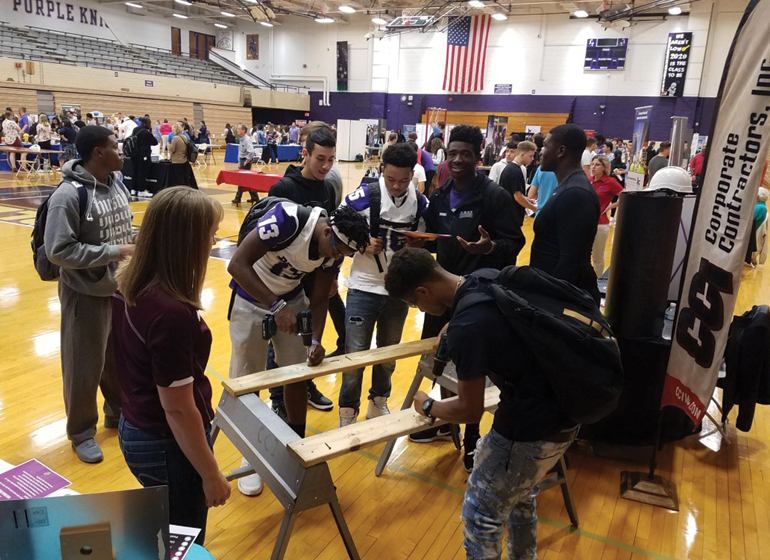STEP 1
Academic and career planning.
In school, you’ve probably worked with a guidance counselor to identify areas of interest. This involves answering a few questions about yourself.
You can speak with mentors who will tell you what you need to know about their jobs: how they got there and what they do. You can then decide if that career is realistic for you.
STEP 2
 Get exposed to business.
Get exposed to business.
Once you’ve identified an area of work you might pursue, get to know local businesses where you might apply your talents and learn new skills.
Some ways to learn about local employers include participating in tours of businesses, going to career fairs and attending information sessions at school. Recruiters offer mock interviews and speed interviewing to sample a variety of industries.
More involved career experiences might include doing a job shadow, where students can go through a day of work at a business to experience the daily challenges of a role.
Internships or co-ops can offer students real-world experience on the job while going to high school or technical college as part of their schooling.
STEP 3

Take a class.
If you’ve found a few interest areas you might like to pursue, find a class to hone your skills. A school guidance counselor can help you map your interests to the class offerings in your school district.
Schools try to line up classes with the needs of the economy in which students will work. Working on machines that real factories use means students are prepared for future jobs.
Beloit Health System, in partnership with Hendricks CareerTek, runs monthly hands-on learning academies focused on a variety of aspects related to nursing. They have regular field trips to medical facilities, a six- to eight-week medical science program, and recruit high schoolers interested in pursuing their CNA license.
STEP 4

Join a club.
Project-based, hands-on learning is one of the best ways to find out what you like to do. You never know unless you try! Many groups, at schools and beyond, offer career exposure to tasks one might perform on the job. Challenges often are presented as contests, with prizes awarded.
Many jobs today and in the future will require STEM skills. A need for greater diversity in these fields is drawing businesses to involve young women in these areas.
STEP 5

Dual enroll.
If you feel like traditional school is not working for you, consider dual enrollment, where students go to school and also work. They earn credits, get experience and are paid. Graduates can use their money toward college, and some even get hired after graduation in a secure job.
School counselors can work with students to personalize a program so every student has a clear pathway to success.
Some kids want something more than the typical teenage job.
Faith Stenson is a student at East Troy High School who graduated in spring 2018 from GPS Education Partners, a program that partners school districts with businesses. She trained as a welder at Banker Wire and plans to attend Gateway Technical College’s welding program.
Most wanted positions
Here are the top jobs companies are hiring for in south central Wisconsin, based on number of employers indicating they hire for such positions on Inspire Madison Region.
Workforce gaps include health sciences, hospitality and tourism, business management, skilled trades and STEM-based careers.
Today’s economy has great need for workers who demonstrate an affinity for science, technology, engineering and math, or like to build, design and create.
Inspire Madison Region is a web-based platform available in public school districts in the region that offers 1,700 career coaches and over 1,300 companies with more than 5,750 experiential learning activities.
- Customer service representative
- Sales representative
- Marketing specialist
- Accountant
- Manufacturing machine operator
- Human resources specialist
- Administrative assistant
- Technical sales representative
- Office manager
- Mechanical engineer
- Receptionist/information clerk
- IT project manager
- Custodian
- Quality controller
- Manufacturing manager
- Shipping & receiving clerk
- Industrial machinery mechanic
- Retail salesperson
- Computer network specialist
- Cook
- Electrical engineer
- Computer support person
- Nurse
- Graphic designer
- Construction manager
- Welder
- Financial manager
- Housekeeper
- Nursing assistant
- Electrician
- Industrial engineer
- Machinist
- Bookkeeper
- Construction laborer
- Cost estimator
- Heavy equipment operator
- Mechanical engineering tech
- Stock clerk
- Carpenter
- Computer software engineer
- Engineering tech
- Industrial engineering tech
- Web developer
- Chef
- Electrical engineering tech
- Licensed practical nurse
- Medical assistant
- Medical lab tech
- Truck driver
- Automotive service technician
Source: Job data from Madison Region Economic Partnership (MadREP), October 2018.


